Table of Contents
Having tabular data can make it challenging to comprehend the data when working with it. Visualizing data or representing it in a pictorial form will enable us to understand better what the information means and how to clean and use it. Tables and CSV files can’t reveal patterns, correlations, or trends.
“Get hands-on with our python course – sign up for a free demo!”
The process of finding trends and correlations in our data by representing it pictorially is called Data Visualization. To perform data visualization in python, we can use various python data visualization modules such as Matplotlib, Seaborn, Plotly, etc.
What is Data Visualization?
Data visualization is a field in data analysis that deals with visual representation of data. It graphically plots data and is an effective way to communicate inferences from data.
Using data visualization, we can get a visual summary of our data. With pictures, maps and graphs, the human mind has an easier time processing and understanding any given data. Data visualization plays a significant role in the representation of both small and large data sets, but it is especially useful when we have large data sets, in which it is impossible to see all our data, let alone process and understand it manually.
As part of the data delivery (DPA) discipline, data detection is also a feature of identifying, retrieving, managing, formatting, and efficiently delivering data.
In large data sets, data viewing helps identify patterns, styles, and vendors by easier identifying patterns, styles, and vendors. Diagrams, charts, information drawings, and visuals are all examples of this term.
Importance of Data Visualization
1: Which of the following data types is immutable in Python?
By visualizing data, businesses can quickly identify trends that would prove challenging. Analysts can visualize new patterns and concepts through the pictorial representation of data sets. Data proliferation, including data visualization, is necessary to make sense of the quintillion bytes of data generated daily.
Data can be visualized and understood using dashboards, graphs, infographics, maps, charts, videos, slides, etc. Data Visualization enables decision-makers to interrelate data to find better insights and reap the benefits of data visualization.
“Ready to take your python skills to the next level? Sign up for a free demo today!”
Advantages of Data Visualization
The advantages of data visualization are listed below
Simple to Understand
Using graphic representations provide us with clear and coherent expressions of vast amounts of data, allows us to understand the data, reach conclusions, and see perspectives. A data visualization tool makes it easy for managers and decision-makers to create and consume critical metrics quickly and easily.
Represent Complex Relationships
Standard visuals, such as bar charts and line graphs, are often inadequate when presenting complex relationships. It is virtually impossible to present a dataset with over a million distinct data points in a standard way.
Making Accessible Key Values
The first benefit of Data Visualization is that it allows massive data sets to be decoded and key values revealed. Especially when it comes to large amounts of data, it can be overwhelming to understand. Visualizing the data helps make key values of the data clear and easy to understand.
Identifying Spots
Our ability to visualize data enables us to recognize emerging trends and respond quickly based on what we see. Identifying strongly correlated parameters is easier when visuals and diagrams are used.
An Understanding of the Story
Dashboards are designed to tell stories. Visuals should be designed in such a way that they help the target audience quickly grasp the story. It would be best to convey the story in the simplest way possible without using excessively detailed visuals.
Ready to take your data science skills to the next level? Sign up for a free demo today!
Data Visualization in Python
Python offers several plotting libraries, namely Matplotlib, Seaborn, Plotly and many other such data visualization packages with different features for creating informative, customized, and appealing plots to present data in the most simple and effective way.
Matplotlib and Seaborn are libraries of Python that are used for data visualization. They have inbuilt modules for plotting different graphs. While Matplotlib is used to embed graphs into applications, Seaborn is primarily used for statistical graphs.
Matplotlib
Matplotlib is the most popular Python plotting library. It is a low-level library with a Matlab-like interface that offers lots of freedom at the cost of having to write more code. Matplotlib is specifically suitable for creating basic graphs like line charts, bar charts, histograms, etc.
Line Charts
A Line chart is a graphical representation of information as a series of data points connected by a straight line. In line charts, each data point or marker is plotted and connected with a line or curve. In Matplotlib, we can create a line chart by calling the plot method. We can also plot multiple columns in one graph by looping through the columns we want and plotting each column on the same axis.
Scatter Plot
To create a scatter plot in Matplotlib, we can use the scatter method. We will also create a figure and an axis using plt.subplots to give our plot a title and labels.
We can give the graph more meaning by coloring each data point by its class. This can be done by creating a dictionary that maps from class to color and then scattering each point on its own using a for-loop and passing the respective color.
Histogram
In Matplotlib, we can create a Histogram using the hist method. If we pass categorical data like the points column from the wine-review dataset, it will automatically calculate how often each class occurs.
Bar Chart
A bar chart can be created using the bar method. The bar chart isn’t automatically calculating the frequency of a category, so we will use pandas value_counts method to do this. The bar chart is useful for categorical data that doesn’t have a lot of different categories (less than 30) because else it can get quite messy.
Seaborn
Seaborn is a Python data visualization library based on Matplotlib. It provides a high-level interface for creating attractive graphs. Seaborn has a lot to offer. For example, you can create graphs in one line that would take multiple tens of lines in Matplotlib.
Line Chart
To create a line chart, the sns.lineplot method can be used. The only required argument is the data, which in our case are the four numeric columns from the Iris dataset. We could also use the sns.kdeplot method, which soothes the edges of the curves and therefore is cleaner if you have a lot of outliers in your dataset. An easy way to make your charts look beautiful is to use some default styles from the Seaborn library. These can be applied globally using the sns.set_style function.
Scatter plot
We can use the .scatterplot method for creating a scatterplot, and just as in Pandas, we need to pass it the column names of the x and y data, but now we also need to pass the data as an additional argument because we aren’t calling the function on the data directly.
Histogram
To create a histogram in Seaborn, we use the sns.distplot method. We need to pass it the column we want to plot, and it will calculate the occurrences itself. We can also pass it the number of bins and if we want to plot a gaussian kernel density estimate inside the graph.
Bar chart
In Seaborn, a bar chart can be created using the sns.countplot method and passing it the data.
But when should we use either of the two data visualizations? We can understand this with the help of a comparative analysis.
The table below provides the difference between Python’s two well-known visualization packages Matplotlib and Seaborn
“Ready to take your python skills to the next level? Sign up for a free demo today!”
|
Matplotlib |
Seaborn |
| It is used for basic graph plotting like line charts, bar graphs, etc. | It is mainly used for statistics visualization and can perform complex visualizations with fewer commands. |
| It mainly works with datasets and arrays. | It works with entire datasets. |
| Seaborn is considerably more organized and functional than Matplotlib and treats the entire dataset as a solitary unit. | Matplotlib acts productively with data arrays and frames. It regards the aces and figures as objects. |
| Seaborn has more inbuilt themes and is mainly used for statistical analysis. | Matplotlib is more customizable and pairs well with Pandas and NumPy for Exploratory Data Analysis. |
Plotly
The plotly.py visualization library is an interactive, open-source, comprehensive, and declarative Python library. A wide variety of useful visualizations are available, such as scientific charts, 3D graphs, statistical charts, and financial charts.
Scatter Plot
Plotly’s scatter() method can be used to create scatter plots. It is also necessary to include an additional data argument, like Seaborn.
Line Chart
In Plotly, line plots are much more accessible and illustrious additions that assemble easy-to-style statistics from various data types. Each position of data is represented as a vertex with px. line
Bar Chart
With plotly.express, you can create bar charts using the bar() method.
Python offers multiple other visualization packages which can be used to create different types of visualizations and not just graphs and plots. It is, therefore, also important to understand the challenges and advantages of the different libraries and how to use them to their full potential.
“Experience the power of our web development course with a free demo – enroll now!”
Data Visualization in Python FAQs
1. Why do we need Data Visualization in Python?
Ans. For creating informative, customized, and appealing plots to present data in the most simple and effective way.
2. What are the two main uses of Data Visualizations?
Ans. Exploration, which helps find a story the data is telling you, and an explanation, which tells a story to an audience.
3. Does Data Visualization require coding?
Ans. Data visualization does not require you to have coding skills.










